
Gatineau is a city in western Quebec, Canada. It is the fourth-largest city in the province after Montreal, Quebec City, and Laval. It is located on the northern bank of the Ottawa River, immediately across from Ottawa, Ontario, together with which it forms Canada's National Capital Region. As of 2016, Gatineau had a population of 276,245, and a metropolitan population of 332,057. The Ottawa–Gatineau census metropolitan area had a population of 1,323,783.
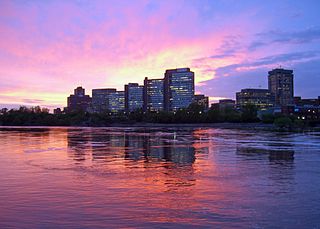
Hull is the central business district and oldest neighbourhood of the city of Gatineau, Quebec, Canada. It is located on the west bank of the Gatineau River and the north shore of the Ottawa River, directly opposite Ottawa. As part of the Canadian National Capital Region, it contains offices for over 20,000 civil servants. It is named after Kingston upon Hull in the United Kingdom.
Philemon Wright was a farmer, lumberman and entrepreneur who founded what he named Columbia Falls Village, mostly known as Wright's Town and Wrightsville to others, the first permanent settlement in the National Capital Region of Canada. Wright's Town, later became incorporated in 1875 and renamed Hull, Quebec, and then in 2002, as a result of a municipal amalgamation, it acquired its present name of the City of Gatineau.

Aylmer is a former city in Quebec, Canada. It is located on the north shore of the Ottawa River and along Route 148. In January 2002, it amalgamated into the city of Gatineau, which is part of Canada's National Capital Region. Aylmer's population in 2011 was 55,113. It is named after Lord Aylmer, who was a governor general of British North America and a lieutenant governor of Lower Canada from 1830 to 1835.
Ruggles Wright was a Canadian lumber merchant, the second youngest son of Philemon Wright.
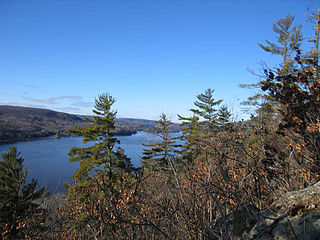
The Gatineau River is a river in western Quebec, Canada, which rises in lakes north of the Baskatong Reservoir and flows south to join the Ottawa River at the city of Gatineau, Quebec. The river is 386 km (239.8 mi) long and drains an area of 23,700 km².

The Chaudière Falls, also known as the Kana:tso or Akikodjiwan Falls, are a set of cascades and waterfall in the centre of the Ottawa-Gatineau metropolitan area in Canada where the Ottawa River narrows between a rocky escarpment on both sides of the river. The location is just west of the Chaudière Bridge and Booth-Eddy streets corridor, northwest of the Canadian War Museum at LeBreton Flats and adjacent to the historic industrial E. B. Eddy complex. The islands surrounding the Chaudière Falls, counter-clockwise, are Chaudière Island, Albert Island, little Coffin Island was just south of Albert Island but is now submerged, Victoria Island and Amelia Island,, Philemon Island was originally called the Peninsular Village by the Wrights but became an island when the timber slide was built in 1829 it is now fused to south shore of City of Gatineau, and Russell Island, now submerged, was at the head of the Falls before the Ring dam was built. The falls are about 60 metres (200 ft) wide and drop 15 metres (49 ft). The area around the falls was once heavily industrialized, especially in the 19th century, driving growth of the surrounding cities.
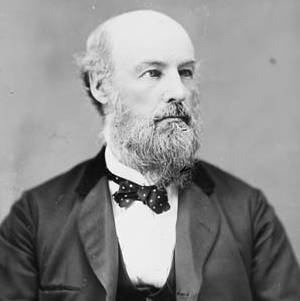
Joseph Merrill Currier was a Canadian member of parliament and businessman.
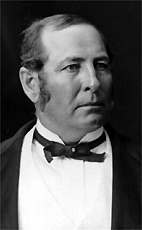
Alonzo Wright was a Canadian member of Parliament and businessman commonly known as "King of the Gatineau".
Charles Shirreff was an early Canadian businessman and public official.
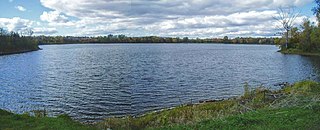
Leamy Lake is a lake in the Hull sector of Gatineau, Quebec, Canada. The lake is located just to the south of the Gatineau River, and just west of the Ottawa River, and is linked to both of them with flowing in from the Gatineau and exiting to the Ottawa. To the south is the Lac de la Carrière, a former quarry that is now a lake that is also linked.
Peter Aylen was a timber producer and later public official who was, for a time, known as "King of the Shiners".
George Hamilton was a lumber baron and public official in Upper Canada.

R v Marshall; R v Bernard 2005 SCC 43 is a leading Aboriginal rights decision of the Supreme Court of Canada where the Court narrowed the test from R. v. Marshall for determining the extent of constitutional protection upon Aboriginal practices. The Court held that there was no right to commercial logging granted in the "Peace and Friendship treaties of 1760", the same set of treaties where the right to commercial fishing was granted in the R. v. Marshall decision. This decision also applied and developed the test for aboriginal title from Delgamuukw v British Columbia.
Philemon Wright High School is an anglophone high school located in the Hull sector of Gatineau, Quebec, Canada. It is administered by the Western Quebec School Board and named after Philemon Wright, founder of Hull. Philemon Wright High school also offers an Enriched French program course to students.
Gatineau is a city in Quebec, Canada.
This is a timeline of the history of Ottawa.

Andrew Leamy was a pioneer industrialist and community leader in Wright's Town, Lower Canada, which became Hull, Quebec and is now incorporated into the City of Gatineau in the National Capital Region of Canada.
The history of Ottawa, capital of Canada, was shaped by events such as the construction of the Rideau Canal, the lumber industry, the choice of Ottawa as the location of Canada's capital, as well as American and European influences and interactions. By 1914, Ottawa's population had surpassed 100,000 and today it is the capital of a G7 country whose metropolitan population exceeds one million.

The Ottawa River timber trade, also known as the Ottawa Valley timber trade or Ottawa River lumber trade, was the nineteenth century production of wood products by Canada on areas of the Ottawa River destined for British and American markets. It was the major industry of the historical colonies of Upper Canada and Lower Canada and it created an entrepreneur known as a lumber baron. The trade in squared timber and later sawed lumber led to population growth and prosperity to communities in the Ottawa Valley, especially the city of Bytown. The product was chiefly red and white pine. The industry lasted until around 1900 as both markets and supplies decreased.